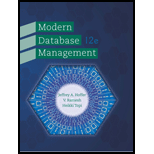
Concept explainers
Develop an EER model for the following situation, using the traditional EER notation, the Visio notation, or the subtypes inside supertypes notation, as specified by your instructor:
A technology company provides offerings to its customers. Offerings are of two separate types: products and services. Offerings are identified by an offering ID and an attribute of description. In addition, products are described by product name, standard price, and date of first release; services are described by name of the company's unit responsible for the service and conditions of service. There are repair, maintenance, and other types of services. A repair service has a cost and is the repair of some product; a maintenance service has an hourly rate. Fortunately, some products never require repair. However, there are many potential repair services for a product. A customer may purchase an offering, and the company needs to keep track of when the offering was purchased and the contact person for that offering with the customer. Unfortunately, not all offerings are purchased. Customers are identified by customer ID and have descriptive data of name, address, and phone number. When a service is performed, that service is billed to some customer. Because some customers purchase offerings for their clients, a customer may be billed for services he or she did not purchase, as well as for ones that were purchased. When a customer is billed for a service (although some may never require a service of any type), the company needs to keep track of the date the service was performed, the date the bill is due, and the amount due.
Trending nowThis is a popular solution!

Chapter 3 Solutions
Modern Database Management (12th Edition)
Additional Engineering Textbook Solutions
Starting Out with Python (4th Edition)
SURVEY OF OPERATING SYSTEMS
BASIC BIOMECHANICS
Database Concepts (8th Edition)
Electric Circuits. (11th Edition)
Thermodynamics: An Engineering Approach
- True or False: Given the sets F and G with F being an element of G, is it always ture that P(F) is an element of P(G)? (P(F) and P(G) mean power sets). Why?arrow_forwardCan you please simplify (the domain is not empty) ∃xF (x) → ¬∃x(F (x) ∨ ¬G(x)). Foarrow_forwardHistogramUse par(mfrow=c(2,2)) and output 4 plots with different argument settings.arrow_forward
- (use R language)Scatter plot(a). Run the R code example, and look at the help file for plot() function. Try different values for arguments:type, pch, lty, lwd, col(b). Use par(mfrow=c(3,2)) and output 6 plots with different argument settings.arrow_forward1. Draw flow charts for each of the following;a) A system that reads three numbers and prints the value of the largest number.b) A system reads an employee name (NAME), overtime hours worked (OVERTIME), hours absent(ABSENT) and determines the bonus payment (PAYMENT).arrow_forwardScenario You work for a small company that exports artisan chocolate. Although you measure your products in kilograms, you often get orders in both pounds and ounces. You have decided that rather than have to look up conversions all the time, you could use Python code to take inputs to make conversions between the different units of measurement. You will write three blocks of code. The first will convert kilograms to pounds and ounces. The second will convert pounds to kilograms and ounces. The third will convert ounces to kilograms and pounds. The conversions are as follows: 1 kilogram = 35.274 ounces 1 kilogram = 2.20462 pounds 1 pound = 0.453592 kilograms 1 pound = 16 ounces 1 ounce = 0.0283 kilograms 1 ounce = 0.0625 pounds For the purposes of this activity the template for a function has been provided. You have not yet covered functions in the course, but they are a way of reusing code. Like a Python script, a function can have zero or more parameters. In the code window you…arrow_forward
- make a screen capture showing the StegExpose resultsarrow_forwardWhich of the following is not one of the recommended criteria for strategic objectives? Multiple Choice a) realistic b) appropriate c) sustainable d) measurablearrow_forwardManagement innovations such as total quality, benchmarking, and business process reengineering always lead to sustainable competitive advantage because everyone else is doing them. a) True b) Falsearrow_forward
- Vision statements are more specific than strategic objectives. a) True b) Falsearrow_forwardThe three components of the __________ approach to corporate accounting include financial, environmental, and social performance measures. Multiple Choice a) stakeholder b) triple dimension c) triple bottom line d) triple efficiencyarrow_forwardCompetitors, as internal stakeholders, should be included in the stakeholder management consideration of a company and in its mission statement. a) True b) Falsearrow_forward

 Fundamentals of Information SystemsComputer ScienceISBN:9781305082168Author:Ralph Stair, George ReynoldsPublisher:Cengage Learning
Fundamentals of Information SystemsComputer ScienceISBN:9781305082168Author:Ralph Stair, George ReynoldsPublisher:Cengage Learning Database Systems: Design, Implementation, & Manag...Computer ScienceISBN:9781305627482Author:Carlos Coronel, Steven MorrisPublisher:Cengage Learning
Database Systems: Design, Implementation, & Manag...Computer ScienceISBN:9781305627482Author:Carlos Coronel, Steven MorrisPublisher:Cengage Learning Principles of Information Systems (MindTap Course...Computer ScienceISBN:9781285867168Author:Ralph Stair, George ReynoldsPublisher:Cengage Learning
Principles of Information Systems (MindTap Course...Computer ScienceISBN:9781285867168Author:Ralph Stair, George ReynoldsPublisher:Cengage Learning A Guide to SQLComputer ScienceISBN:9781111527273Author:Philip J. PrattPublisher:Course Technology Ptr
A Guide to SQLComputer ScienceISBN:9781111527273Author:Philip J. PrattPublisher:Course Technology Ptr Database Systems: Design, Implementation, & Manag...Computer ScienceISBN:9781285196145Author:Steven, Steven Morris, Carlos Coronel, Carlos, Coronel, Carlos; Morris, Carlos Coronel and Steven Morris, Carlos Coronel; Steven Morris, Steven Morris; Carlos CoronelPublisher:Cengage Learning
Database Systems: Design, Implementation, & Manag...Computer ScienceISBN:9781285196145Author:Steven, Steven Morris, Carlos Coronel, Carlos, Coronel, Carlos; Morris, Carlos Coronel and Steven Morris, Carlos Coronel; Steven Morris, Steven Morris; Carlos CoronelPublisher:Cengage Learning





